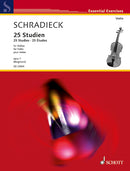| 作曲者 | Henry Schradieck (1846-1918)・ヘンリ・シュラディーク |
| タイトル | 25 Studien op. 1 |
| 出版社 | Schott・ショット |
| シリーズ名 | Essential Exercises |
| 楽器編成 | violin |
| 品番 | 9790001200240 |
| 編曲者 | Benjamin Bergmann |
| 難易度 | 中級〜上中級 |
| 形状 | 96 ページ・中綴じ |
| 出版年 | 2017年 |
| 出版番号 | ED 22004 |
| ISMN | 9790001200240 |
Henry Schradieck chose the modest designation studies for his exercises. Their musical substance, however, goes far beyond that of a study. They are character pieces which get their captivating musical expression particularly from the harmonic progression and expressive melodic lines while the rhythm remains relatively consistent to maximize the effect of practising. The pieces are basically caprices (capriccios) which disregard formal rules in an imaginative and playful manner.24 Études Caprices by Jean Delphin Alard, the studies cover all major and minor scales of the circle of fifths. In addition to the original fingerings, this edition also contains alternative fingering variants which include both playing in the second position and modern change-of-position techniques like creeping and pivoting.Each study is preceded by short explanations of the editor Benjamin Bergmann concerning the contents and objectives of each study as well as by practical technical information on the performance. This edition is published in the Essential Exercises study series which contains proven practical study works for instrumental lessons.
C major: Saitenübergänge im Legato - A minor: Gegenläufiges Aufsetzen und Heben der Finger - G major: Bariolage im Legato - E minor: Ricochet mit zwei Tönen und Saitenwechsel - D major: Terzen und Sexten mit dichtem Legato - B minor: Legato espressivo - A major: Doppelgriffe: Melodie und Begleitung - F sharp minor: Gebrochene und simultane Terzen im Legato - E major: Doppelgriff-Oktaven im Legato - C sharp minor: Gebrochene Doppelgriffe im Legato - B major: Gebrochene Sexten im Wieniawski-Strich - G sharp minor: Expressives Legatospiel - F sharp major: Bariolage und Terzen - G flat major: Doppelgriffe in Oktaven, Terzen und Sexten - E flat major: Geläufigkeit der linken Hand im Legato - D flat major: Unabhängigkeit der Finger - B flat minor: Legato espressivo - A flat major: Punktierte Rhythmen - F minor: Doppelgriffe mit versetztem Tonwechsel - E flat major: Détaché mit Saitenwechsel über 2-4 Saiten - C minor: Thema mit Variationen - B major: Sautillé mit Tonrepetionen - G minor: Doppelgriffe in Terzen und Sexten - F major: Geschmeidigkeit der Bogen- und Saitenwechsel - D minorl: Staccato im Auf- und Abstrich



